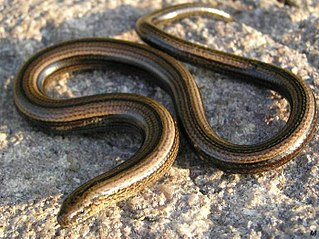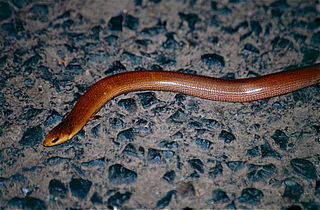
Ophioscincus is a genus of skink found in Australia.

The three-toed earless skink is a viviparous earless skink from southeastern Australia.

Legless lizard may refer to any of several groups of lizards that have independently lost limbs or reduced them to the point of being of no use in locomotion. It is the common name for the family Pygopodidae. These lizards are often distinguishable from snakes on the basis of one or more of the following characteristics: possessing eyelids, possessing external ear openings, lack of broad belly scales, notched rather than forked tongue, having two more-or-less-equal lungs, and/or having a very long tail. Every stage of reduction of the shoulder girdle —including complete loss— occurs among limbless squamates, but the pelvic girdle is never completely lost regardless of the degree of limb reduction or loss. At least the ilium is retained in limbless lizards and most basal snakes.
Anomalopus mackayi, commonly known as the five-clawed worm skink, long-legged worm skink, and Mackay's burrowing skink, is a species of smooth-scaled burrowing skink, a lizard in the family Scincidae. The species is endemic to eastern Australia.

The western three-toed skink is a species of lizard with tiny legs in the family Scincidae. It is found in the Iberian Peninsula, southern France and parts of northwestern Italy. Its natural habitats are temperate forests, temperate shrubland, Mediterranean-type shrubby vegetation, temperate grassland, sandy shores, arable land, pastureland, and rural gardens. It was first described 1829 by the French naturalist Georges Cuvier. The generic name comes from the Greek "chalcides" meaning 'copper' and the specific name is derived from the Latin "striatus" meaning 'streak'.

The three-toed snake-tooth skink is a species of skink in the family Scincidae. It is endemic to south-eastern Queensland and north-eastern New South Wales, Australia. It occurs in subtropical rainforest, wet sclerophyll forest, and montane forest on rich dark soils on the coast and adjacent ranges; some coastal/island populations occur on pale sands in lowlands.
Gyldenstolpe's worm skink, also known commonly as Gyldenstolpe's isopachys and Gyldenstolpe's snake skink, is a species of lizard in the family Scincidae. The species is endemic to Thailand.

The short-nosed snake is a species of venomous snake in the family Elapidae. The species is endemic to Australia. Short-nosed snakes are endemic to swamplands and coastlands in the southwest of Western Australia, where they shelter in nests of stick ants, as well as dense rushes and reed tussocks. Short-nosed snakes are known to prey on small skinks mainly from the skink genus hemiergis, and small species of frogs.

Bougainville's skink is a species of skink, a lizard in the family Scincidae. This species is also commonly called the south-eastern slider and Bougainville's lerista.

Cryptoblepharus virgatus, also commonly known as striped snake-eyed skink, cream-striped shinning-skink, wall skink, fence skink or snake-eyed skink is a skink commonly found in southern and eastern Australia. It is an active little lizard, and if threatened will often play dead to confuse the attacker.
Techmarscincus is a genus of skink, a lizard in the family Scincidae. The genus is endemic to Australia, and is monotypic, containing the sole species Techmarscincus jigurru.

Trachylepis capensis is a species of skink, a lizard in the family Scincidae. The species is native to southern Africa.

The two-toed earless skink is a common species of skink found in coastal south-western, Western Australia. It is characterized by its long tail, an absence of ear-holes, shiny skin, yellow underside, and short weak limbs, each of which with only two toes. It can grow to be over 10 cm in length, however the average size is approximately 7.5 cm. It also exhibits a snake-like movement, and due to the small size and non-functionality of limbs in locomotion, it is often referred to as a legless lizard.

Cryptoblepharus australis, commonly called the inland snake-eyed skink, is a species of skink in the genus Cryptoblepharus.

The Centralian blue-tongued skink or Centralian blue-tongue is a species of skink, occurring predominantly in the far north-west corner of New South Wales, Australia. It is one of six species belonging to the genus Tiliqua; the blue-tongued skinks and the shinglebacks. This species of reptile classifies as a lizard.
Cryptoblepharus mertensi, also known commonly as Merten's snake-eyed skink, is a species of lizard in the family Scincidae. The species is endemic to the Northern Territory in Australia.
Cryptoblepharus pannosus, also known commonly as the ragged snake-eyed skink, is a species of lizard in the family Scincidae. The species is endemic to Australia.

The saltbush Morethia skink, or more commonly referred to as saltbush skink, is a species of skink found in Australia. They are part of an 8 species genus of Morethia, which are all endemic to Australia. Akin to other members of the Morethia genus, saltbush skinks feature transparent disks as eye covers and eyelids which are stationary, along with specialised limbs which enable quick traversal of sand dunes. Taxonomically, the species was first classified by German explorer Wilhelm Karl Hartwig in 1871.
The limbless snake-tooth skink is a species of skink. It is endemic to north-eastern Queensland, Australia. It is a large, fossorial skink that occurs in the rainforest of coastal ranges and lowlands.
The yolk-bellied snake-skink is a species of skink found in Queensland in Australia.














